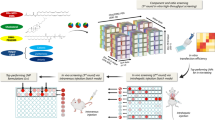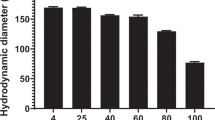Abstract
The expression efficiency in liver following hydrodynamic delivery of in vitro transcribed mRNA was improved 2000-fold using a codon-optimized mRNA luciferase construct with flanking 3' and 5' human β-globin untranslated regions (UTR mRNA) over an unoptimized mRNA without β-globin UTRs. Nanoparticle UTR mRNA polyplexes were formed using a novel polyacridine polyethylene glycol (PEG) peptide, resulting in an additional 15-fold increase in expression efficiency in the liver. The combined increase in expression for UTR mRNA PEG-peptide polyplexes was 3500-fold over mRNA lacking UTRs and PEG-peptide. The expression efficiency of UTR mRNA polyplex was 10-fold greater than the expression from an equivalent 1 μg dose of pGL3. Maximal expression was maintained from 4 to 24 h. Serum incubation established the unique ability of the polyacridine PEG-peptide to protect UTR mRNA polyplexes from RNase metabolism by binding to double-stranded regions. UTR mRNA PEG-peptide polyplexes are efficient nonviral vectors that circumvent the need for a nuclear uptake, representing an advancement toward the development of a targeted gene delivery system to transfect liver hepatocytes.
This is a preview of subscription content, access via your institution
Access options
Subscribe to this journal
Receive 12 print issues and online access
$259.00 per year
only $21.58 per issue
Buy this article
- Purchase on Springer Link
- Instant access to full article PDF
Prices may be subject to local taxes which are calculated during checkout






Similar content being viewed by others
References
Wu GY, Wu CH . Receptor-mediated Gene Delivery and Expression In Vivo. J Biol Chem 1988; 263: 14621–14624.
Wooddell CI, Rozema DB, Hossbach M, John M, Hamilton HL, Chu Q et al. Hepatocyte-targeted RNAi therapeutics for the treatment of chronic hepatitis B virus infection. Mol Ther 2013; 21: 973–985.
Chuah MK, Evens H, VandenDriessche T . Gene therapy for hemophilia. J Thromb Haemost 2013; 11: 99–110.
Richard M, Arfi A, Seguin J, Gandolphe C, Scherman D . Widespread biochemical correction of murine mucopolysaccharidosis type VII pathology by liver hydrodynamic plasmid delivery. Gene Therapy 2009; 16: 746–756.
Pun SH, Davis ME . Development of a nonviral gene delivery vehicle for systemic application. Bioconjug Chem 2002; 13: 630–639.
Lenter MC, Garidel P, Pelisek J, Wagner E, Ogris M . Stabilized nonviral formulations for the delivery of MCP-1 gene into cells of the vasculoendothelial system. Pharm Res 2004; 21: 683–691.
Read ML, Logan A, Seymour LW . Barriers to gene delivery using synthetic vectors. In Hall JC, Dunlap JC, Friedmann T, van Heyningen V eds Advances in Genetics. Academic Press: Amsterdam, 2005, pp 19–46.
Hu Y, Haynes MT, Wang Y, Liu F, Huang L . A highly efficient synthetic vector: nonhydrodynamic delivery of DNA to hepatocyte nuclei in vivo. ACS Nano 2013; 7: 5376–5384.
Liu F, Song Y, Liu D . Hydrodynamics-based transfection in animals by systemic administration of plasmid DNA. Gene Therapy 1999; 6: 1258–1266.
Al Dosari MS, Knapp JE, Liu D, Huang L . Hydrodynamic Delivery. In Advances in Genetics. Academic Press: Amsterdam, 2005, pp 65–82.
Zhang G, Gao X, Song YK, Vollmer R, Stolz DB, Gaskowski JZ et al. Hydroporation as the mechanism of hydrodynamic delivery. Gene Therapy 2004; 11: 675–682.
Andrianaivo F, Lecocq M, Wattiaux-De Coninck S, Wattiaux R, Jadot M . Hydrodynamics-based transfection of the liver: entrance into hepatocytes of DNA that causes expression takes place very early after injection. J Gene Med 2004; 6: 877–883.
Hodges BL, Scheule RK . Hydrodynamic delivery of DNA. Expert Opin Biol Ther 2003; 3: 911–918.
Sahin U, Kariko K, Tureci O . mRNA-based therapeutics–developing a new class of drugs. Nat Rev Drug Discov 2014; 13: 759–780.
Wolff JA, Malone RW, Williams P, Chong W, Acsadi G, Jani A et al. Direct gene transfer into mouse muscle in vivo. Science 1990; 247: 1465–1468.
Deering RP, Kommareddy S, Ulmer JB, Brito LA, Geall AJ . Nucleic acid vaccines: prospects for non-viral delivery of mRNA vaccines. Expert Opin Drug Deliv 2014; 11: 885–899.
Phua KK, Leong KW, Nair SK . Transfection efficiency and transgene expression kinetics of mRNA delivered in naked and nanoparticle format. J Control Release 2013; 166: 227–233.
Schlake T, Thess A, Fotin-Mleczek M, Kallen KJ . Developing mRNA-vaccine technologies. RNA Biol 2012; 9: 1319–1330.
Kariko K, Muramatsu H, Keller JM, Weissman D . Increased erythropoiesis in mice injected with submicrogram quantities of pseudouridine-containing mRNA encoding erythropoietin. Mol Ther 2012; 20: 948–953.
Malone RW, Felgner PL, Verma IM . Cationic liposome-mediated RNA transfection. Proc Natl Acad Sci USA 1989; 86: 6077–6081.
Kormann MS, Hasenpusch G, Aneja MK, Nica G, Flemmer AW, Herber-Jonat S et al. Expression of therapeutic proteins after delivery of chemically modified mRNA in mice. Nat Biotechnol 2011; 29: 154–157.
Zangi L, Lui KO, von Gise A, Ma Q, Ebina W, Ptaszek LM et al. Modified mRNA directs the fate of heart progenitor cells and induces vascular regeneration after myocardial infarction. Nat Biotechnol 2013; 31: 898–907.
Phua KK, Staats HF, Leong KW, Nair SK . Intranasal mRNA nanoparticle vaccination induces prophylactic and therapeutic anti-tumor immunity. Sci Rep 2014; 4: 5128.
Perche F, Benvegnu T, Berchel M, Lebegue L, Pichon C, Jaffres PA et al. Enhancement of dendritic cells transfection in vivo and of vaccination against B16F10 melanoma with mannosylated histidylated lipopolyplexes loaded with tumor antigen messenger RNA. Nanomedicine 2011; 7: 445–453.
Avci-Adali M, Behring A, Keller T, Krajewski S, Schlensak C, Wendel HP . Optimized conditions for successful transfection of human endothelial cells with in vitro synthesized and modified mRNA for induction of protein expression. J Biol Eng 2014; 8: 8.
Cheng C, Convertine AJ, Stayton PS, Bryers JD . Multifunctional triblock copolymers for intracellular messenger RNA delivery. Biomaterials 2012; 33: 6868–6876.
Debus H, Baumhof P, Probst J, Kissel T . Delivery of messenger RNA using poly(ethylene imine)-poly(ethylene glycol)-copolymer blends for polyplex formation: biophysical characterization and in vitro transfection properties. J Control Release 2010; 148: 334–343.
Wang Y, Su HH, Yang Y, Hu Y, Zhang L, Blancafort P et al. Systemic delivery of modified mRNA encoding herpes simplex virus 1 thymidine kinase for targeted cancer gene therapy. Mol Ther 2013; 21: 358–367.
Uchida S, Itaka K, Uchida H, Hayakawa K, Ogata T, Ishii T et al. In vivo messenger RNA introduction into the central nervous system using polyplex nanomicelle. PLoS One 2013; 8: e56220.
McCaffrey AP, Ohashi K, Meuse L, Shen S, Lancaster AM, Lukavsky PJ et al. Determinants of hepatitis C translational initiation in vitro, in cultured cells and mice. Mol Ther 2002; 5: 676–684.
Wilber A, Frandsen JL, Geurts JL, Largaespada DA, Hackett PB, McIvor RS . RNA as a source of transposase for Sleeping Beauty-mediated gene insertion and expression in somatic cells and tissues. Mol Ther 2006; 13: 625–630.
Baumhover NJ, Anderson K, Fernandez CA, Rice KG . Synthesis and in vitro testing of new potent polyacridine-melittin gene delivery peptides. Bioconjug Chem 2010; 21: 74–86.
Fernandez CA, Baumhover NJ, Duskey JT, Khargharia S, Kizzire K, Ericson MD et al. Metabolically stabilized long-circulating pegylated polyacridine peptide polyplexes mediate hydrodynamically stimulated gene expression in liver. Gene Therapy 2011; 18: 23–37.
Kizzire K, Khargharia S, Rice KG . High-affinity PEGylated polyacridine peptide polyplexes mediate potent in vivo gene expression. Gene Therapy 2013; 20: 407–416.
Khargharia S, Kizzire K, Ericson MD, Baumhover NJ, Rice KG . PEG length and chemical linkage controls polyacridine peptide DNA polyplex pharmacokinetics, biodistribution, metabolic stability and in vivo gene expression. J Control Release 2013; 170: 325–333.
Khargharia S, Baumhover NJ, Crowley ST, Duskey J, Rice KG . The uptake mechanism of PEGylated DNA polyplexes by the liver influences gene expression. Gene Therapy 2014; 21: 1021–1028.
Gruber AR, Lorenz R, Bernhart SH, Neubock R, Hofacker IL . The Vienna RNA websuite. Nucleic Acids Res 2008; 36: W70–W74.
Boussif O, Lezoualc'h F, Zanta MA, Mergny MD, Scherman D, Demeneix B et al. A versatile vector for gene and oligonucleotide transfer into cells in culture and in vivo: polyethylenimine. Proc Natl Acad Sci USA 1995; 92: 7297–7301.
Pedroso de Lima MC, Simoes S, Pires P, Faneca H, Duzgunes N . Cationic lipid-DNA complexes in gene-delivery: from biophysics to biological applications. Adv Drug Deliv Rev 2001; 47: 277–294.
Haynes MT, Huang L . Lipid-coated calcium phosphate nanoparticles for nonviral gene therapy. Adv Genet 2014; 88: 205–229.
Wagner E . Polymers for nucleic acid transfer-an overview. Adv Genet 2014; 88: 231–261.
Wolff JA, Budker V . The mechanism of naked DNA uptake and expression. Adv Genet 2005; 54: 3–20.
Pante N, Kann M . Nuclear pore complex is able to transport macromolecules with diameters of about 39 nm. Mol Biol Cell 2002; 13: 425–434.
Pollard H, Remy JS, Loussouarn G, Demolombe S, Behr JP, Escande D . Polyethylenimine but not cationic lipids promotes transgene delivery to the nucleus in mammalian cells. J Biol Chem 1998; 273: 7507–7511.
Rozema DB, Lewis DL, Wakefield DH, Wong SC, Klein JJ, Roesch PL et al. Dynamic polyconjugates for targeted in vivo delivery of siRNA to hepatocytes. Proc Natl Acad Sci USA 2007; 104: 12982–12987.
Rettig GR, Behlke MA . Progress toward in vivo use of siRNAs-II. Mol Ther 2012; 20: 483–512.
Rettig G, McAnuff M, Kim J, Liu D, Rice KG . Quantitative bioluminscence imaging of transgene expression in vivo. Anal Biochem 2006; 335: 90–94.
Holtkamp S, Kreiter S, Selmi A, Simon P, Koslowski M, Huber C et al. Modification of antigen-encoding RNA increases stability, translational efficacy, and T-cell stimulatory capacity of dendritic cells. Blood 2006; 108: 4009–4017.
Ward CM, Read ML, Seymour LW . Systemic circulation of poly(L-lysine)/DNA vectors is influenced by polycation molecular weight and type of DNA: differential circulation in mice and rats and the implications for human gene therapy. Blood 2001; 97: 2221–2229.
Oupicky D, Konak C, Dash PR, Seymour LW, Ulbrich K . Effect of albumin and polyanion on the structure of DNA complexes with polycation containing hydrophilic nonionic block. Bioconjug Chem 1999; 10: 764–772.
Anderson BR, Muramatsu H, Jha BK, Silverman RH, Weissman D, Kariko K . Nucleoside modifications in RNA limit activation of 2'-5'-oligoadenylate synthetase and increase resistance to cleavage by RNase L. Nucleic Acids Res 2011; 39: 9329–9338.
Kariko K, Muramatsu H, Welsh FA, Ludwig J, Kato H, Akira S et al. Incorporation of pseudouridine into mRNA yields superior nonimmunogenic vector with increased translational capacity and biological stability. Mol Ther 2008; 16: 1833–1840.
Kim H, Kim J-S . A guide to genome engineering with programmable nucleases. Nat Rev Genet 2014; 15: 321–334.
Acknowledgements
We gratefully acknowledge support from NIH Grants GM097093 and T32 GM008365 (STC and JAP).
Author information
Authors and Affiliations
Corresponding author
Ethics declarations
Competing interests
The authors declare no conflict of interest.
Additional information
Supplementary Information accompanies this paper on Gene Therapy website
Supplementary information
Rights and permissions
About this article
Cite this article
Crowley, S., Poliskey, J., Baumhover, N. et al. Efficient expression of stabilized mRNA PEG-peptide polyplexes in liver. Gene Ther 22, 993–999 (2015). https://doi.org/10.1038/gt.2015.68
Received:
Revised:
Accepted:
Published:
Issue Date:
DOI: https://doi.org/10.1038/gt.2015.68
This article is cited by
-
Nucleic acid drug vectors for diagnosis and treatment of brain diseases
Signal Transduction and Targeted Therapy (2023)
-
Upregulation of long non-coding RNA LOC284454 may serve as a new serum diagnostic biomarker for head and neck cancers
BMC Cancer (2020)



